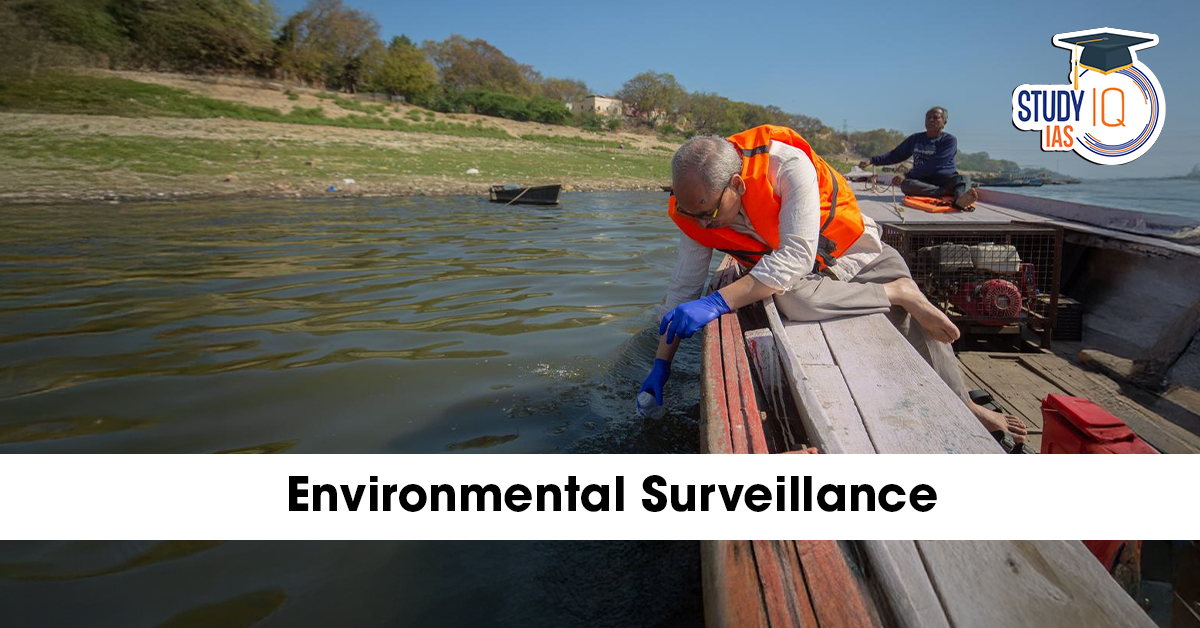Table of Contents
Context
Environmental surveillance, especially through wastewater monitoring, is emerging as a critical tool for India to detect, prevent, and manage disease outbreaks more effectively.
| What is Environmental Surveillance? |
How Does It Work?
|
Why is Environmental Surveillance Important? (Significance)
- Early Warning System
- Detects outbreaks before symptoms appear widely.
- Helps in timely deployment of medicines, vaccines, and hospital preparedness.
- Captures Asymptomatic & Untested Cases: Traditional clinical surveillance misses those who don’t show symptoms or avoid testing.
- Public Health Planning: Helps policymakers understand true infection burden in a community. Crucial for resource allocation (beds, oxygen, vaccines).
- Supports Disease Eradication: Used globally for polio, measles, cholera eradication campaigns.
- Cost-effective and Scalable: Monitoring sewage is cheaper than testing millions of individuals.
- Links to One Health: Tracks zoonotic pathogens (like avian flu) and antimicrobial resistance, protecting both human and animal health.
|
India’s Current Efforts |
|
Challenges in India
- Fragmented Approach: Project-driven efforts; no integrated national programme yet.
- Standardisation Issues: Lack of uniform sampling protocols and data-sharing across states.
- Infrastructure Gaps: Many Indian cities lack functional sewage treatment plants (STPs), especially in tier-2/3 towns.
- Data Management: Weak centralised systems for analysing and sharing results with public health authorities.
- Funding & Skilled Manpower: Limited trained microbiologists, epidemiologists, and lab technicians.
- Privacy & Ethics: Concerns about misusing surveillance data for targeting communities.
- Neglect of Rural Areas: Surveillance efforts are largely urban; rural India faces equal, if not greater, risks.
Way Forward
- National Wastewater Surveillance System: A centralised framework under ICMR/NDMA integrated with routine disease surveillance.
- Standard Protocols: Develop common templates for sampling, sequencing, and data reporting across states.
- Expand Infrastructure: Invest in modern sewage treatment plants and lab facilities across all major urban centres.
- Integration with Health Policy: Link surveillance with National Health Mission, Ayushman Bharat, and NDHM.
- Capacity Building: Train public health professionals, epidemiologists, and municipal staff in sample handling and genomic analysis.
- Community Transparency & Ethics: Publish results openly to build public trust and avoid stigma.
- Leverage Technology: Use AI/ML tools for predicting outbreaks; integrate with early-warning dashboards for health planners.
- Explore novel surveillance methods (e.g., audio monitoring, air sampling in crowded spaces).
- Global Best Practices: Learn from countries like the Netherlands and Australia, where wastewater surveillance is part of national health systems.
- Align with WHO’s Global Polio Laboratory Network and emerging global initiatives for pandemic preparedness.


 Telangana’s Bathukamma Festival Create...
Telangana’s Bathukamma Festival Create...
 E-Waste Recycling in India: Informal Sec...
E-Waste Recycling in India: Informal Sec...
 International Civil Aviation Organizatio...
International Civil Aviation Organizatio...




















